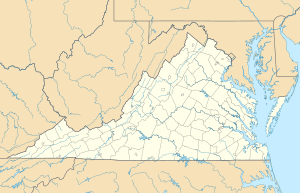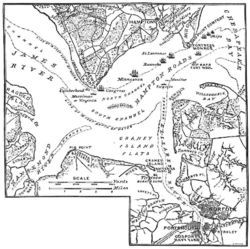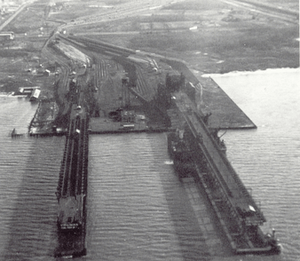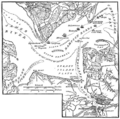Sewell's Point facts for kids
Quick facts for kids Sewell's Point |
|
|---|---|
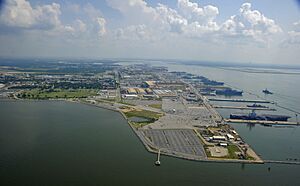
Sewell's Point viewed from the north, 2011
|
|
| Location | Virginia, United States |
| Coordinates | 36°57′18″N 76°19′37″W / 36.9548696°N 76.3268873°W |
| Offshore water bodies | |
| Elevation | 7 ft (2.1 m) |
| Geology | Cape |
Sewells Point is a piece of land shaped like a finger, sticking out into the water in Norfolk, Virginia. It's located right where the Hampton Roads harbor meets the sea. Water surrounds Sewells Point on three sides: Willoughby Bay to the north, Hampton Roads to the west, and the Lafayette River to the south. Today, it's home to Naval Station Norfolk, which is the biggest naval base in the world!
Contents
How Sewells Point Got Its Name
This area was first named in the 1600s after a man named Henry Seawell. He was an Englishman who came to Virginia before 1632.
Over time, people spelled the name in different ways, like Sowells Point or Seawells Point. But today, the most common spelling is Sewells Point.
The First Church in Norfolk
Around 1637, a church area called Elizabeth River Parish was created. The very first church for this parish was built between 1638 and 1640. It was located "at Mr. Seawell's Pointe."
This church was one of the first in the area now known as South Hampton Roads. It stood somewhere within what is now the US Naval Station Norfolk. The Episcopal churches in Norfolk today can trace their history back to this first church.
How Weather Shaped the Land
Even though Hampton Roads is a safe harbor, big storms can change its shorelines. Long ago, when English settlers first arrived in Jamestown in 1607, Willoughby Bay didn't even exist!
The area called Willoughby is named after Thomas Willoughby, who came to Virginia in 1610. He received a land grant (a gift of land) around 1625. His son, Thomas II, lived there in the 1660s. A local story says that after a huge storm (maybe the "Harry Cane" of 1667), his wife woke up to see a new piece of land where there had only been water. The Willoughby family quickly claimed this "new" property.
Strong storms and hurricanes kept changing the coast for over a century. In a hurricane in 1749, the Chesapeake Bay rose 15 feet (4.6 m) higher than normal. This storm created a sand spit at Sewells Point. Then, the Great Coastal Hurricane of 1806 helped form Willoughby Spit. The water between Sewells Point and Willoughby Spit became known as Willoughby Bay.
Sewells Point During the Civil War
Sewells Point was very important during the early part of the Civil War. Its location at the entrance to Hampton Roads made it a key spot.
The Battle of Sewells Point
The first fight in Virginia during the Civil War was the Battle of Sewells Point. It happened on May 18–19, 1861, right where the US Naval Station Norfolk is today.
Why the Battle Happened
In December 1860, South Carolina left the Union. A few months later, in April 1861, troops fired on Fort Sumter. Five days later, Virginia also left the Union and joined the Confederacy.
To bring the states back, US General Winfield Scott suggested a plan to President Lincoln. Instead of attacking the Confederate army, he wanted to block off their coastline and control the Mississippi River. Lincoln ordered a blockade of the Southern coast. On April 20, the Union Navy burned and left the Norfolk Navy Yard. This left only Fort Monroe as a Union stronghold in Virginia.
The Confederacy took over Norfolk, gaining a major shipyard and many heavy guns. Confederate General Walter Gwynn set up batteries (groups of cannons) at Sewells Point. These batteries were meant to protect Norfolk and control Hampton Roads.
The Union sent ships to Hampton Roads to enforce the blockade. On May 18–19, Union gunboats and the Confederate batteries at Sewells Point exchanged fire. Not much damage was done to either side.
What Happened in the Battle
On May 18, 1861, Confederate troops started building defenses at Sewells Point. By evening, they had set up some cannons. The USS Monticello, a Union ship, came over from Fort Monroe to see what was happening. The captain ordered his ship to fire. One shot hit the Confederate battery, sending dirt flying. The Monticello was joined by another armed boat.
The Union ships' firing caused some confusion among the Confederates. But they quickly got ready to fire back with their own cannons. Since they didn't have a Confederate flag yet, they raised the Georgia flag instead. The Union ships left for the night, but the Monticello stayed near Sewells Point.
During the night, the Confederates worked hard to finish their defenses. The next day, the firing started again in the late afternoon. The Monticello was hit several times and had to return to Fort Monroe. This was the first battle on Virginia soil during the Civil War.
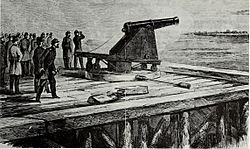
No one died in this battle, and only one Confederate soldier was hurt. The Sewells Point batteries were fired upon many times after this, but they were never captured. Later, when Confederate forces left Norfolk on May 10, 1862, the batteries were abandoned.
The Battle of Hampton Roads
The famous Battle of Hampton Roads happened near Sewells Point on March 8–9, 1862.
In this battle, the USS Monitor from the Union Navy fought against the CSS Virginia from the Confederate States Navy.
This battle was important because it was the first time two powered, ironclad warships (ships covered in metal armor) fought each other. The battle ended without a clear winner.
President Lincoln at Sewells Point
On May 5, 1862, President Lincoln came to Hampton Roads on a ship called the Miami. He wanted to personally lead the Union army's efforts. The next day, Lincoln directed Union gunboats to fire on Sewells Point. He wanted to see if troops could land there and move on Norfolk.
Lincoln learned that the Confederates were leaving Norfolk. He ordered Union ships to shell the Confederate batteries at Sewells Point. The Confederates still had some strength there.
On May 9, 1862, President Lincoln himself looked for a good place for troops to land near Sewells Point. He found an unfortified spot. The next morning, Union troops landed there. Lincoln then ordered troops to march on Norfolk. They arrived late on May 10.
On May 10, 1862, Confederate forces set the Norfolk Navy Yard on fire before leaving. Union troops crossed Hampton Roads, landed, and captured Norfolk. With the area back under Union control, the batteries at Sewells Point were no longer important and were abandoned. For the rest of the 1800s, the area remained mostly undeveloped.
Sewells Point in the 1900s
In the early 1900s, two big events at Sewells Point helped lead to the creation of the world's largest naval base.
Building the Virginian Railway
In the 1890s, a civil engineer named William N. Page had an idea. He knew about rich bituminous coal fields in southern West Virginia that no major railroads reached yet.
He bought a small logging railroad and expanded it, calling it the Deepwater Railway. He planned to connect it with other railroads. However, the bigger railroads, the Chesapeake and Ohio Railway (C&O) and the Norfolk and Western Railway (N&W), didn't want to work with him. They secretly agreed to block his plans.
But Page didn't give up. He kept building his railroad, which puzzled the big companies. They didn't know that one of Page's secret investors was Henry H. Rogers, a very rich man from the Standard Oil company. Rogers wasn't going to let his investment fail. So, he and Page secretly planned to build their own railroad all the way from West Virginia to Hampton Roads!
They formed another company, the Tidewater Railway, for the part of the railroad in Virginia. They bought land and planned the route very quietly. They even had surveyors pretend to be fishermen to map out parts of the line. They made deals with towns along the way, including Norfolk. They needed land at Sewells Point to build a new coal pier. Norfolk even gave them a path around the city to reach Sewells Point.
In 1905, with their land and route secured, Page (still keeping Rogers' identity a secret) started building the rest of the railroad. By the time the bigger railroads realized what was happening, it was too late to stop them. Rogers' involvement was finally revealed in 1907. The Deepwater and Tidewater Railways were combined to form the Virginian Railway (VGN).
The Norfolk part of the new Virginian Railway was finished just in time to serve the Jamestown Exposition, which opened in the spring of 1907 right next to the VGN coal pier site at Sewells Point.
The Virginian Railway was built to very high standards, using new construction methods and Rogers' own money. It was an amazing engineering feat. The last spike was driven on January 29, 1909.
In April 1909, Rogers was celebrated in Norfolk. He visited the railway's new $2.5 million coal pier at Sewells Point, and Mark Twain even spoke at a big dinner.
The Virginian Railway and its location at Sewells Point were important for the US Navy. It was right next to the former Exposition grounds, which became a Navy facility in 1917. The VGN carried high-quality coal that the US Navy preferred for its ships.
When the VGN merged with the Norfolk & Western in 1959, civilian coal loading moved to another location. A few years later, the Navy bought the Sewells Point site. Today, the former VGN site is part of the United States' Naval Station Norfolk.
The Jamestown Exposition of 1907
The Jamestown Exposition was a big world's fair held from April 26 to December 1, 1907, at Sewells Point. It celebrated 300 years since the Jamestown Settlement was founded in 1607.
Leaders in Norfolk wanted to host this celebration. The original Jamestown site was too isolated and didn't have facilities for large crowds. Many thought Richmond, the state capital, would be chosen.
However, a newspaper in Norfolk argued that Norfolk was the best place. It said Norfolk was the center of Virginia's population and had many historical and business reasons to host the event.
By 1902, the Jamestown Exposition Co. was formed. They decided to hold the international fair on a mile-long stretch of land at Sewells Point. This location was a good compromise because it was about the same distance from Norfolk, Portsmouth, Newport News, and Hampton. It was hard to reach by land, but easy to reach by water, which turned out to be helpful.
Building the Exposition was a huge challenge. Roads had to be built, piers constructed, and hotels raised for the nearly 3 million visitors. Bad weather also slowed things down.
On opening day, only a few lights worked, and some areas weren't ready. The ground was muddy from construction. But over time, things got better, and the event became spectacular.
Each state was asked to build a house to show its history and industry. Twenty-one states built houses, like the Pennsylvania House and Virginia House. During the Exposition, special days honored each state. Thirteen of these state houses can still be seen today at Naval Station Norfolk, on a street called "Admiral's Row." Many are now homes for high-ranking Navy officers.
US President Theodore Roosevelt was a special guest. Mark Twain and Henry H. Rogers also visited. Twain gave a funny speech.
Even though the Exposition didn't make money, it served an important purpose for America and for Norfolk.
Perhaps the most impressive part of the Exposition was on the water. Many Navy ships, including sixteen battleships, were present off Sewells Point. This fleet stayed in Hampton Roads after the Exposition closed. It became President Roosevelt's Great White Fleet, which sailed around the world to show America's military strength. Many important politicians saw the Exposition, and Navy admirals wanted to create a naval base there.
Finally, on June 28, 1917, President Woodrow Wilson set aside $2.8 million to buy land and build facilities for the base. Most of the land (367 acres out of 474) was the old Jamestown Exposition grounds. The military property grew even larger later. The former Virginian Railway coal piers and land were added in the 1960s and 1970s.
Sewells Point Today
Naval Station Norfolk now covers Sewells Point. The base is about 4,000 acres (16 km2) and is the largest naval base in the world.
It is home to the headquarters of the Atlantic Fleet, the 2nd Fleet, and NATO commands. The Naval Complex includes Naval Station Norfolk, NAS Norfolk, and other Navy facilities in the Hampton Roads area.
When the 78 ships and 133 aircraft based there are not at sea, they are at one of the 14 piers or in one of the 15 aircraft hangars. This is for repairs, training, and for the crews to be with their families. The base is home to aircraft carriers, cruisers, destroyers, large amphibious ships, submarines, and many supply ships. The port handles over 3,100 ship movements each year. Its facilities stretch over four miles (6 km) along the waterfront and include about seven miles (11 km) of pier space.
Images for kids
-
Major General Benjamin Butler showing the Sawyer gun at Fort Calhoun, 1861


